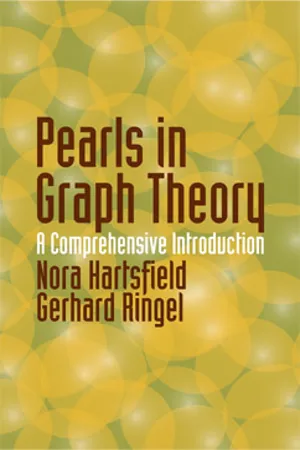
eBook - ePub
Pearls in Graph Theory
A Comprehensive Introduction
Nora Hartsfield, Gerhard Ringel
This is a test
- 272 Seiten
- English
- ePUB (handyfreundlich)
- Über iOS und Android verfügbar
eBook - ePub
Pearls in Graph Theory
A Comprehensive Introduction
Nora Hartsfield, Gerhard Ringel
Angaben zum Buch
Buchvorschau
Inhaltsverzeichnis
Quellenangaben
Über dieses Buch
`Innovative introductory text . . . clear exposition of unusual and more advanced topics . . . Develops material to substantial level.` — American Mathematical Monthly
`Refreshingly different . . . an ideal training ground for the mathematical process of investigation, generalization, and conjecture leading to the discovery of proofs and counterexamples.` — American Mathematical Monthly
` . . . An excellent textbook for an undergraduate course.` — Australian Computer Journal
A stimulating view of mathematics that appeals to students as well as teachers, this undergraduate-level text is written in an informal style that does not sacrifice depth or challenge. Based on 20 years of teaching by the leading researcher in graph theory, it offers a solid foundation on the subject. This revised and augmented edition features new exercises, simplifications, and other improvements suggested by classroom users and reviewers. Topics include basic graph theory, colorings of graphs, circuits and cycles, labeling graphs, drawings of graphs, measurements of closeness to planarity, graphs on surfaces, and applications and algorithms. 1994 edition.
`Refreshingly different . . . an ideal training ground for the mathematical process of investigation, generalization, and conjecture leading to the discovery of proofs and counterexamples.` — American Mathematical Monthly
` . . . An excellent textbook for an undergraduate course.` — Australian Computer Journal
A stimulating view of mathematics that appeals to students as well as teachers, this undergraduate-level text is written in an informal style that does not sacrifice depth or challenge. Based on 20 years of teaching by the leading researcher in graph theory, it offers a solid foundation on the subject. This revised and augmented edition features new exercises, simplifications, and other improvements suggested by classroom users and reviewers. Topics include basic graph theory, colorings of graphs, circuits and cycles, labeling graphs, drawings of graphs, measurements of closeness to planarity, graphs on surfaces, and applications and algorithms. 1994 edition.
Häufig gestellte Fragen
Wie kann ich mein Abo kündigen?
Gehe einfach zum Kontobereich in den Einstellungen und klicke auf „Abo kündigen“ – ganz einfach. Nachdem du gekündigt hast, bleibt deine Mitgliedschaft für den verbleibenden Abozeitraum, den du bereits bezahlt hast, aktiv. Mehr Informationen hier.
(Wie) Kann ich Bücher herunterladen?
Derzeit stehen all unsere auf Mobilgeräte reagierenden ePub-Bücher zum Download über die App zur Verfügung. Die meisten unserer PDFs stehen ebenfalls zum Download bereit; wir arbeiten daran, auch die übrigen PDFs zum Download anzubieten, bei denen dies aktuell noch nicht möglich ist. Weitere Informationen hier.
Welcher Unterschied besteht bei den Preisen zwischen den Aboplänen?
Mit beiden Aboplänen erhältst du vollen Zugang zur Bibliothek und allen Funktionen von Perlego. Die einzigen Unterschiede bestehen im Preis und dem Abozeitraum: Mit dem Jahresabo sparst du auf 12 Monate gerechnet im Vergleich zum Monatsabo rund 30 %.
Was ist Perlego?
Wir sind ein Online-Abodienst für Lehrbücher, bei dem du für weniger als den Preis eines einzelnen Buches pro Monat Zugang zu einer ganzen Online-Bibliothek erhältst. Mit über 1 Million Büchern zu über 1.000 verschiedenen Themen haben wir bestimmt alles, was du brauchst! Weitere Informationen hier.
Unterstützt Perlego Text-zu-Sprache?
Achte auf das Symbol zum Vorlesen in deinem nächsten Buch, um zu sehen, ob du es dir auch anhören kannst. Bei diesem Tool wird dir Text laut vorgelesen, wobei der Text beim Vorlesen auch grafisch hervorgehoben wird. Du kannst das Vorlesen jederzeit anhalten, beschleunigen und verlangsamen. Weitere Informationen hier.
Ist Pearls in Graph Theory als Online-PDF/ePub verfügbar?
Ja, du hast Zugang zu Pearls in Graph Theory von Nora Hartsfield, Gerhard Ringel im PDF- und/oder ePub-Format sowie zu anderen beliebten Büchern aus Mathematics & Mathematics General. Aus unserem Katalog stehen dir über 1 Million Bücher zur Verfügung.
Information
Thema
MathematicsThema
Mathematics GeneralChapter 1

BASIC GRAPH THEORY
1.1 Graphs and Degrees of Vertices
Before we give any definitions and theory, let us consider the following example. There is a basket containing an apple, a banana, a cherry and a date. Four children named Erica, Frank, Greg and Hank are each to be given a piece of the fruit. Erica likes cherries and dates; Frank likes apples and cherries; Greg likes bananas and cherries; and Hank likes apples, bananas, and dates. Figure 1.1.1 describes the situation. The problem is to give each child a piece of fruit that he or she likes. The reader is invited to find a solution. One can see the advantage of using Figure 1.1.1 as an aid to solving the problem.
Figure 1.1.1 is, in fact, an example of a graph. Another example with which we are all familiar is a road map. The map in Figure 1.1.2 is greatly simplified, of course. It shows some different ways of driving from San Jose to San Francisco.

Figure 1.1.1

Figure 1.1.2
Chemists use diagrams to picture molecules, and these diagrams are also graphs. Usually the hydrogen atoms are omitted from the diagrams by the chemists using shorthand structure, but the Kekulé structure includes them.

Figure 1.1.3. Water, H2O.

Figure 1.1.4. Butane and isobutane, C4H10.
In Figures 1.1.6 and 1.1.7 the labels for carbon, hydrogen, and oxygen have been left out. See Figure 1.3.6 for another molecule C60.
Graph theory is used in designing printed circuits for use in electronics devices. Circuits printed on silicon chips must be designed differently from those using insulated wires, since the conducting portions cannot cross one another. The graph of Figure 1.1.8 shows part of a printed circuit used in a computer.

Figure 1.1.5. Cyclohexane, C6H12.

Figure 1.1.6. Aspirin, C9H8O4.
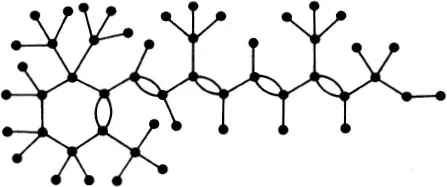
Figure 1.1.7. Vitamin A, C20H30O.
Algorithms can also be described by graphs. The graph of Figure 1.1.9 is a chart of the steps used in an algorithm for solving a certain problem using a computer.

Figure 1.1.8. Portion of a printed circuit

Figure 1.1.9
In the study of lattices and Boolean algebras, graphs arise as diagrams of these structures. Those who have studied set theory will recognize the diagrams of Figures 1.1.10 and 1.1.11 as lattices of subsets. For convenience, we use shorter notation for sets; for example, we write ABD for the set {A, B, D}. The diagrams of Figures 1.1.10 and 1.1.11 show all subsets of the set at the top. If one set is derived from another by deleting one element, then the two sets are connected by a line in the diagram.
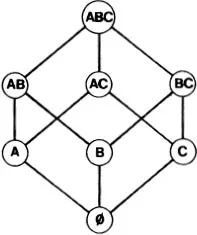
Figure 1.1.10. The lattice of subsets of ABC.
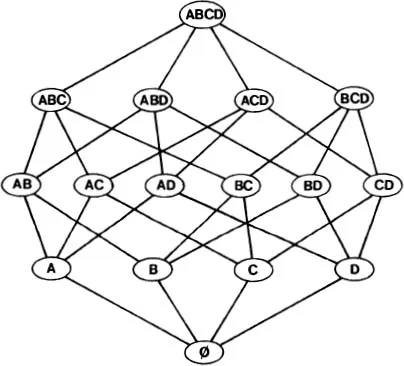
Figure 1.1.11
The different factorizations of the integer 60 are shown in the diagram of Figure 1.1.12. Some more examples of graphs are shown in Figures 1.1.13, 1.1.14, 1.1.15, 1.1.16, and 1.1.17.
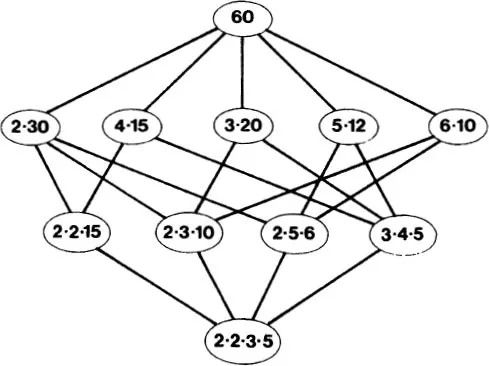
Figure 1.1....
Inhaltsverzeichnis
Zitierstile für Pearls in Graph Theory
APA 6 Citation
Ringel, G. (2013). Pearls in Graph Theory ([edition unavailable]). Dover Publications. Retrieved from https://www.perlego.com/book/112656/pearls-in-graph-theory-a-comprehensive-introduction-pdf (Original work published 2013)
Chicago Citation
Ringel, Gerhard. (2013) 2013. Pearls in Graph Theory. [Edition unavailable]. Dover Publications. https://www.perlego.com/book/112656/pearls-in-graph-theory-a-comprehensive-introduction-pdf.
Harvard Citation
Ringel, G. (2013) Pearls in Graph Theory. [edition unavailable]. Dover Publications. Available at: https://www.perlego.com/book/112656/pearls-in-graph-theory-a-comprehensive-introduction-pdf (Accessed: 14 October 2022).
MLA 7 Citation
Ringel, Gerhard. Pearls in Graph Theory. [edition unavailable]. Dover Publications, 2013. Web. 14 Oct. 2022.